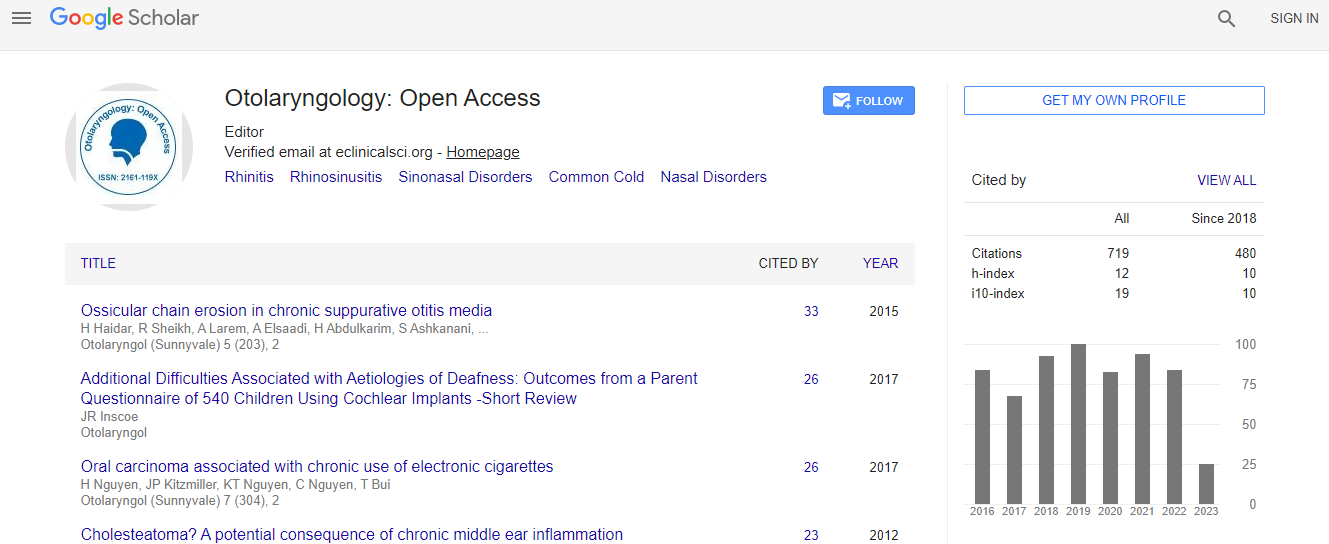Our Group organises 3000+ Global Conferenceseries Events every year across USA, Europe & Asia with support from 1000 more scientific Societies and Publishes 700+ Open Access Journals which contains over 50000 eminent personalities, reputed scientists as editorial board members.
Open Access Journals gaining more Readers and Citations
700 Journals and 15,000,000 Readers Each Journal is getting 25,000+ Readers
Google Scholar citation report
Citations : 925
Otolaryngology: Open Access received 925 citations as per Google Scholar report
Otolaryngology: Open Access peer review process verified at publons
Indexed In
- Index Copernicus
- Google Scholar
- Sherpa Romeo
- Open J Gate
- Genamics JournalSeek
- RefSeek
- Hamdard University
- EBSCO A-Z
- OCLC- WorldCat
- Publons
- Geneva Foundation for Medical Education and Research
- ICMJE
Useful Links
Recommended Journals
Related Subjects
Share This Page
Predictive biomarkers for treatment response in Head and Neck cancer
Joint Event on 4th European Otolaryngology-ENT Surgery Conference & 3rd International Conference on Craniofacial Surgery
Karin Roberg
Division of Cell Biology, Department of Clinical and Experimental Medicine, Linkoping University, Linkoping, SwedenDepartment of Otorhinolaryngology in Linkoping, Anaesthetics, Operations and Specialty Surgery Center, Region Ostergotland, Sweden
Posters & Accepted Abstracts: Otolaryngol (Sunnyvale)
Abstract
Head and Neck Squamous Cell Carcinoma (HNSCC) tumors are often resistant to therapies. Therefore searching for predictive markers and new targets for treatment in clinically relevant. The aim of these studies was to evaluate the impact of hypoxia and on CSC/EMT phenotype on response to therapy of HNSCC cells. HNSCC cell lines were cultured in 2D and 3D models under normoxic (21% O2) or hypoxic (1% O2) conditions and the treatment sensitivity for radiation, cisplatin, cetuximab and dasatinib was assessed using a crystal violet assay or a MTT assay. Expression of epithelial (e.g. E-cadherin) and mesenchymal markers (e.g. N-cadherin, vimentin) and markers for CSC (Nanog, Sox) were analyzed on mRNA and protein level. In 2D, HNSCC cells became significantly more resistant to cetuximab, cisplatin and radiation as well as significantly more sensitive to dasatinib treatment under hypoxia. Hypoxia-induced EMT was attributed to HIF-1α overexpression and was observed in all analyzed cells, markedly in cell lines possessing epithelial-like phenotype. Additionally, hypoxia led to augmentation of stem cell transcription factors. In 3D, all spheroids showed an up regulation of CDH1, NANOG and SOX2 in comparison to 2D but changes in the expression of EGFR and EMT markers varied among the cell lines. Moreover, most HNSCC cells grown in 3D showed decreased sensitivity to cisplatin and cetuximab (anti-EGFR) treatment. In summary, the 2D study shows that hypoxia is a predominant cause of chemo- and radioresistance as well as EMT in HNSCC cells. When comparing our two models we found notable differences between these two cellular systems in terms of EMT-associated gene expression profile and drug response. As the 3D cell cultures imitate the in vivo behaviour of neoplastic cells within the tumor, our study suggest that 3D culture model is superior to 2D monolayers in the search for new therapeutic targets.Biography

 Spanish
Spanish  Chinese
Chinese  Russian
Russian  German
German  French
French  Japanese
Japanese  Portuguese
Portuguese  Hindi
Hindi 
